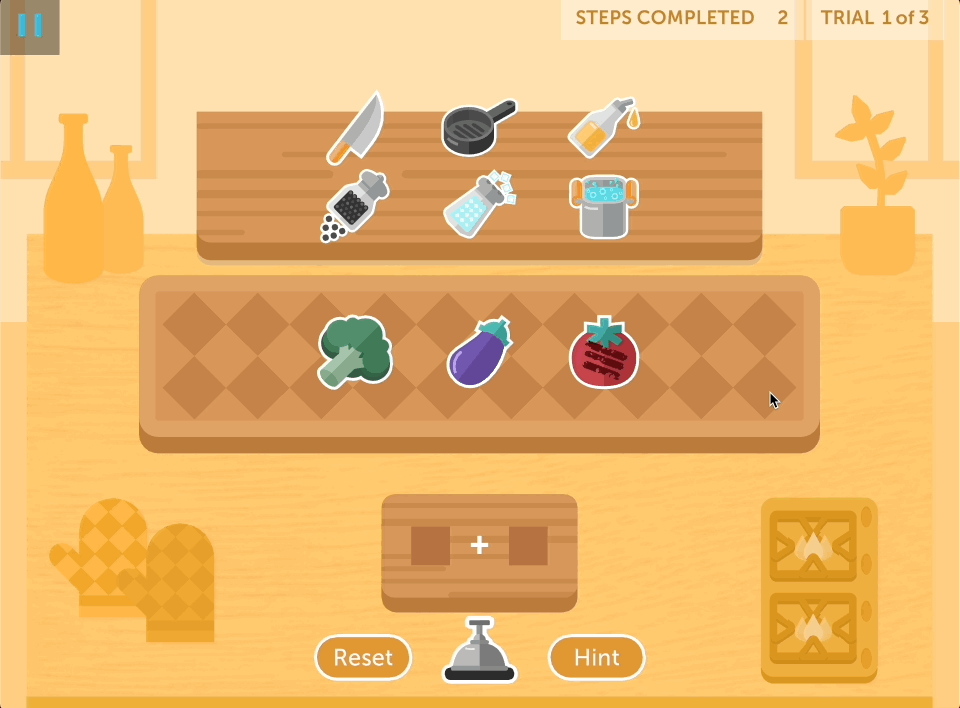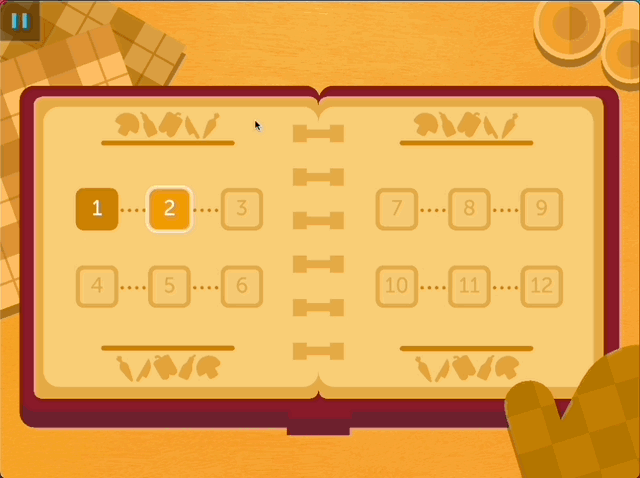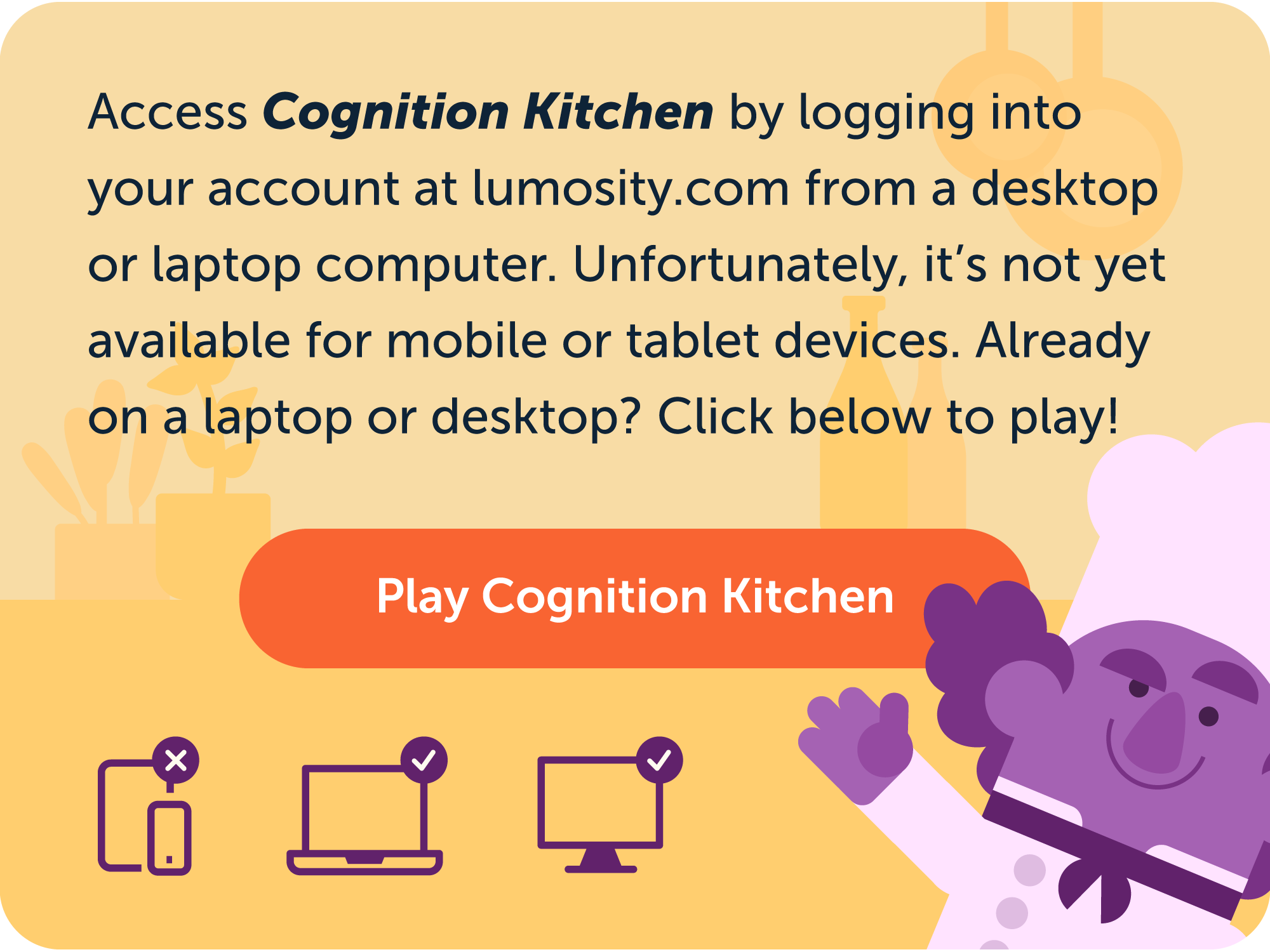
NEW Game: Cognition Kitchen - Recipe Recall
Let’s face it: cooking is a hectic activity. Or, at least it can be. Even those who seem to dance around their counters with grace will have to admit the great potential for chaos that exists inside every kitchen – especially when following a new recipe.
In fact, the same can be true when following instructions for any new activity, whether it’s using a new device, assembling furniture, or carrying out new work responsibilities. We’ve all been there. We find ourselves clinging to each step of the instructions, often revisiting the same step over and over again just to remember what we’re supposed to be doing and what we’re about to do, all while trying to actually do it. Our memory is taxed and our attention is divided.
But what if you could prepare for those cognitive demands without making any messes or even stepping foot in your kitchen? For that exact purpose, we’re inviting you to train in our very own Cognition Kitchen. Keep reading to learn about how the game works, the science behind it, and how it all came to be.
Read all the way to the end for some expert advice on how to improve your score!
How to Play Cognition Kitchen
Chef Crouton is the Head Chef of Cognition Kitchen and he specializes in experimental cuisine. In fact, he’ll never make the same recipe more than once. Your job in Cognition Kitchen is to memorize his crazy recipes and then prepare them without using your cookbook.

Each round will start on the Recipe Screen where you’ll memorize a series of steps consisting of actions and ingredients (i.e. chop the tomato). You’ll notice a timer above your cookbook – take as long as you want, but Chef Crouton will reward you with a bonus for speedier memorization.

Once you think you’ve got it down, click “Ready to Cook” and move on to The Kitchen where you’ll carry out the steps you just memorized. You can get hints if you’re stuck, or reset if you think you made a mistake. Once the recipe is complete to the best of your memory, ring the bell to signal your completion. Once you do, you’ll find out how you did based on the following criteria:
Correct Steps: How many of the recipe steps did you complete correctly?
Steps in Order: How many of the recipe steps did you do in the intended order?
Extra Steps: How many steps did you take that were not part of the recipe?
Hints used: How many hints did you use?
Resets: How many times did you reset?

As you progress, the game will get harder by presenting longer recipes. Along the way, you’ll unlock new ingredients and kitchen tools to add complexity. You may also notice that the first few levels will group similar steps together - i.e. chop tomato, salt tomato, boil tomato. This takes advantage of “chunking”, which typically makes memorization easier. Later levels, however, will no longer group steps together in this way, making them more challenging.
The Science of Following Instructions
Would you believe that cognitive researchers have a procedure for the study of people following procedures? Well, they do! It was developed to better understand the cognitive processes involved and was aptly named, The Following Instructions Task.
At first, it may not seem like there’s much to study from a cognitive perspective. After all, a person following instructions is simply doing what they’re told. But if you think about everything that goes on in your mind while following instructions, the inherent challenges become more obvious. Fundamentally, researchers view Following Instructions as an application of Working Memory, which is used to store, process, and integrate information during complex and demanding activities. The crux is not just in remembering the steps or their sequence, but in retaining those steps during the act of carrying them out. This conflict of attention – between trying to recall the recipe and doing the actual cooking – is called interference, where executing the action interferes with our ability to continue remembering the information.
Following directions to a new location, learning a dance routine, and remembering items from a shopping list while we’re at the store all involve these two cognitive components: Working Memory and dealing with interference.
With all this in mind, we built Cognition Kitchen around the same key functions as The Following Instructions Task. But of course, our game designers are focused on more than just challenging your brain, they also have the important goal of making it fun!
Game Design: How to Make Following Instructions Fun
We almost made a furniture-building game. But it wasn’t a crowd favorite.
Ultimately, we found that following a recipe was the best fit for this exercise and the most fun for our play testers. Cooking is familiar, popular, and involves a lot of recognizable actions and tools for everyone around the world. There’s also a lot of room for variety and complexity to shape the difficulty on harder levels.
The next challenge we ran into was creating the recipes themselves. There was a natural temptation to base the game on “real” recipes, which would add a practical and rewarding element to each play. The problem though is that “real” recipes are too predictable and familiar. The memory component of the game would be lost as players would be able to use intuition and experience to predict what they are supposed to do next rather than memorizing it. As a result, we had to randomize the recipes in order to preserve the cognitive challenge of the task.
Finally came time to bring it all to life visually. Indeed the creation of this game involved more illustration and animation work than any other Lumosity game. This was largely due to the decision to make the recipes entirely visual, rather than written, which helps to avoid confusion and makes the game easier to translate into different languages. To take things further, we also needed to visualize different states of the food (i.e. whole vs chopped, raw vs cooked). This helps players keep track of what they’ve already done in a realistic manner.
Pro tip: If at any point you want to review all of the kitchen tools and foods in their various states, you can pause the game, go to “How To Play” and head to the glossary. This can be a useful reference to familiarize yourself with the game’s visual language.

Game Tips: How to Excel in Cognition Kitchen
Chunking - On early levels, recipes are made easier to remember by “chunking” similar steps together within the sequence. For example, all of the tomato-related steps might be together, followed by all the broccoli-related steps. Take advantage while you can. Say things to yourself like “chop, salt, and cut the tomato” to remember all the steps grouped around the same food item.
Say it Aloud - Speaking of saying things to yourself, this is great advice for a lot of our games. Saying the steps aloud can help you remember them during memorization, and keep track of what step you’re on when you’re preparing the recipe.
Time - Remember that the time component is only for a bonus. It’s icing on the cake, you might say. Whenever you first advance to a new level, you may want to ignore this component and use it only to challenge yourself later.
Visualization - During the memorization phase, take time to visualize each action, simulating the actions in your mind.

